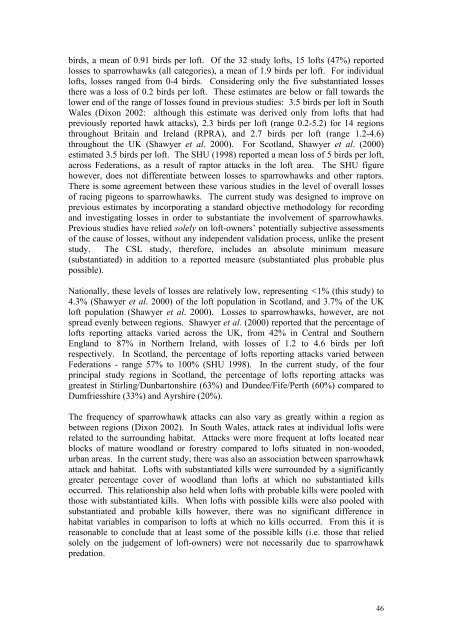RACING PIGEONS â IMPACT OF RAPTOR PREDATION
RACING PIGEONS â IMPACT OF RAPTOR PREDATION
RACING PIGEONS â IMPACT OF RAPTOR PREDATION
You also want an ePaper? Increase the reach of your titles
YUMPU automatically turns print PDFs into web optimized ePapers that Google loves.
irds, a mean of 0.91 birds per loft. Of the 32 study lofts, 15 lofts (47%) reported<br />
losses to sparrowhawks (all categories), a mean of 1.9 birds per loft. For individual<br />
lofts, losses ranged from 0-4 birds. Considering only the five substantiated losses<br />
there was a loss of 0.2 birds per loft. These estimates are below or fall towards the<br />
lower end of the range of losses found in previous studies: 3.5 birds per loft in South<br />
Wales (Dixon 2002: although this estimate was derived only from lofts that had<br />
previously reported hawk attacks), 2.3 birds per loft (range 0.2-5.2) for 14 regions<br />
throughout Britain and Ireland (RPRA), and 2.7 birds per loft (range 1.2-4.6)<br />
throughout the UK (Shawyer et al. 2000). For Scotland, Shawyer et al. (2000)<br />
estimated 3.5 birds per loft. The SHU (1998) reported a mean loss of 5 birds per loft,<br />
across Federations, as a result of raptor attacks in the loft area. The SHU figure<br />
however, does not differentiate between losses to sparrowhawks and other raptors.<br />
There is some agreement between these various studies in the level of overall losses<br />
of racing pigeons to sparrowhawks. The current study was designed to improve on<br />
previous estimates by incorporating a standard objective methodology for recording<br />
and investigating losses in order to substantiate the involvement of sparrowhawks.<br />
Previous studies have relied solely on loft-owners’ potentially subjective assessments<br />
of the cause of losses, without any independent validation process, unlike the present<br />
study. The CSL study, therefore, includes an absolute minimum measure<br />
(substantiated) in addition to a reported measure (substantiated plus probable plus<br />
possible).<br />
Nationally, these levels of losses are relatively low, representing
















